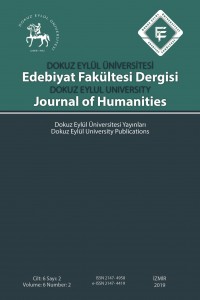Öz
Once upon a time Sigmund Freud proclaimed that technology was the means by
which to push humans beyond the edge of their biological limits, transforming them
into ‘a kind of prosthetic’ God. By the time humans began to dominate the world,
many animal species had already disappeared because of man’s hunger. This was
the first indicator that humans were prone to determine the fate of other species. The
wars they fought, massacres they ordered, and extinctions they caused. The center of
the world was not large enough, while the center of the universe was occupied by
God. Dante Alighieri imagined the planets through their proximity to the Sun as our
juxtaposition to God. For humankind, the inability to control themselves was
disturbing enough. Zamiatin, in his We, created a dystopian world at the edge of
Armageddon in which people become the subjects of a long-lasting project that
portrays religions as myths. The aim of this study is to display the imaginable cost of
playing God through science, which is presumably designed to make life easier, not
to replace God.
Anahtar Kelimeler
Post-human Transhumanism Pantheism Dystopia Science Technology Destruction God
Kaynakça
- Reference 1 Atsma, A. J. (n.d.). Dionysus, http://www.theoi.com/Olympios/Dionysos.html [accessed 18 February 2017].
- Reference 2 Bernheimer, R., (1979). Wild men in the Middle Ages. Cambridge: Harvard University Press, 1952; New York: Octagon books, ISBN 0-374-90616-5.
- Reference 3 Bible hub, 1 John 2:15-17, https://biblehub.com/1_john/2-15.htm [accessed 10 June 2019].
- Reference 4 Bolter, J. D., (2016). Posthumanism, The International Encyclopedia of Communication Theory and Philosophy. JohnWiley & Sons, Inc. DOI: 10.1002/9781118766804.wbiect220
- Reference 5 Booker, M. K., (1994). Dystopian Literature A Theory and Research Guide. London: Greenwood Press.
- Reference 6 Bostrom, N., (2005). A History of Transhumanist Thought. Journal of Evolution and Technology ‐ (Vol. 14 Issue 1 ‐ April 2005) [Originally published in; reprinted (in its present slightly edited form) in Academic Writing Across the Disciplines, eds. Michael Rectenwald & Lisa Carl (New York: Pearson Longman, 2011)]
- Reference 7 Bostrom, N., (2003). Human Genetic Enhancements: A Transhumanist Perspective. Journal of Value Inquiry (2003, Vol. 37, No. 4, pp. 493-506).
- Reference 8 Columbus reports on his first voyage, (1493), A Spotlight on a Primary Source by Christopher Columbus, The Gilder Lehrman Institute of American History, https://www.gilderlehrman.org/content/columbus-reports-his-first-voyage-1493
- Reference 9 Freud, S., (1930). Civilization and its Discontents. https://www.gradesaver.com/civilization-and-its-discontents/study-guide/summary-chapters-5-6 [accessed 10 June 2019].
- Reference 10 Tolkien, J.R.R., (n.d.), On Fairy Stories, http://www.rivendellcommunity.org/Formation/Tolkien_On_Fairy_Stories.pdf [accessed January 2019].
- Reference 11 Zamiatin, Eugene, (1952). We. (Translated and with a Foreword by Gregory Zilboorg, Introduction by Peter Rudy, Preface by Marc Slonim), New York: BY E. P. DUTTON & CO., INC. (Copyright, 1924, Copyright renewal, 1952, By Gregory Zilboorg SBN 0-525-47039-5).
Öz
Bir zamanlar Sigmund Freud, teknolojinin, insanları bir tür prostetik tanrı(lar)a
dönüştürmek amacıyla, biyolojik limitlerinin ötesine taşıyan bir yol olduğunu
açıklamıştı (ki hâlâ öyle). İnsanoğlu dünya üzerinde ikamet etmeye başladığında, birçok hayvan türü, insanın açlığından ötürü zaten çoktan yok olmuştu bile. Bu,
insanoğlunun başkalarının kaderlerine karar verme eğiliminin ilk işaretiydi. Savaşlar
yaptı; katliamlar gerçekleştirdi, nesillerin yok olmasına sebep oldu. Evrenin merkezi
tanrı tarafından işgal edilmişken, dünyanın merkezi yeterince büyük değildi
insanoğlu için. Dante Alighieri, gezegenleri güneşe olan yakınlıklarıyla hayal etti;
tıpkı bizim tanrıyla yan yana duruşumuz gibi. Kendi bedenini kontrol edebilme
yetisisne sahip olamamak yeterince rahatsız ediciydi zaten insan için. We
romanında, insanların, dinleri mitler olarak tanımlayan, uzun süreli bir projenin
nesneleri haline geldiği, mahşerin kıyısında distopyan bir dünya yarattı Zamiatin. Bu
çalışmanın amacı, tanrının yerine geçmekten ziyade, muhtemelen hayatı
kolaylaştırmak için tasarlanan bilimi kullanarak tanrıyı oynamanın öngörülebilir
bedelini ortaya çıkarmaktır.
Anahtar Kelimeler
İnsan üstü İnsan ötesi Panteizm Distopya Bilim Teknoloji Destrüksiyon Tanrı
Kaynakça
- Reference 1 Atsma, A. J. (n.d.). Dionysus, http://www.theoi.com/Olympios/Dionysos.html [accessed 18 February 2017].
- Reference 2 Bernheimer, R., (1979). Wild men in the Middle Ages. Cambridge: Harvard University Press, 1952; New York: Octagon books, ISBN 0-374-90616-5.
- Reference 3 Bible hub, 1 John 2:15-17, https://biblehub.com/1_john/2-15.htm [accessed 10 June 2019].
- Reference 4 Bolter, J. D., (2016). Posthumanism, The International Encyclopedia of Communication Theory and Philosophy. JohnWiley & Sons, Inc. DOI: 10.1002/9781118766804.wbiect220
- Reference 5 Booker, M. K., (1994). Dystopian Literature A Theory and Research Guide. London: Greenwood Press.
- Reference 6 Bostrom, N., (2005). A History of Transhumanist Thought. Journal of Evolution and Technology ‐ (Vol. 14 Issue 1 ‐ April 2005) [Originally published in; reprinted (in its present slightly edited form) in Academic Writing Across the Disciplines, eds. Michael Rectenwald & Lisa Carl (New York: Pearson Longman, 2011)]
- Reference 7 Bostrom, N., (2003). Human Genetic Enhancements: A Transhumanist Perspective. Journal of Value Inquiry (2003, Vol. 37, No. 4, pp. 493-506).
- Reference 8 Columbus reports on his first voyage, (1493), A Spotlight on a Primary Source by Christopher Columbus, The Gilder Lehrman Institute of American History, https://www.gilderlehrman.org/content/columbus-reports-his-first-voyage-1493
- Reference 9 Freud, S., (1930). Civilization and its Discontents. https://www.gradesaver.com/civilization-and-its-discontents/study-guide/summary-chapters-5-6 [accessed 10 June 2019].
- Reference 10 Tolkien, J.R.R., (n.d.), On Fairy Stories, http://www.rivendellcommunity.org/Formation/Tolkien_On_Fairy_Stories.pdf [accessed January 2019].
- Reference 11 Zamiatin, Eugene, (1952). We. (Translated and with a Foreword by Gregory Zilboorg, Introduction by Peter Rudy, Preface by Marc Slonim), New York: BY E. P. DUTTON & CO., INC. (Copyright, 1924, Copyright renewal, 1952, By Gregory Zilboorg SBN 0-525-47039-5).
Ayrıntılar
| Birincil Dil | İngilizce |
|---|---|
| Bölüm | Makaleler |
| Yazarlar | |
| Yayımlanma Tarihi | 22 Ekim 2019 |
| Gönderilme Tarihi | 18 Temmuz 2019 |
| Yayımlandığı Sayı | Yıl 2019 Cilt: 6 Sayı: 2 |


